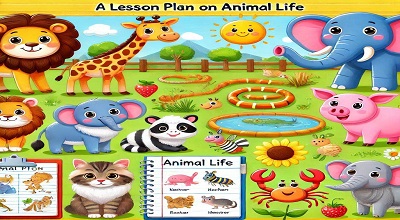Lesson Plan on Animal Life
A Lesson Plan on Animal Life. There are many different animal life cycles, and they can vary depending on the type of animal, the environment they live in, and the way they reproduce. Some animals go through a process called metamorphosis, which means they change their shape or form as they grow. Other animals are born looking like smaller versions of their parents, and they grow and develop until they are mature enough to have offspring of their own. Here are some web resources that can help you learn more about animal life cycles:
Title: Exploring Animal Life
Grade Level: Elementary (3rd – 5th grade)
Objective:
Students will learn about the diversity of animal life, their characteristics, habitats, and adaptations through various activities and discussions.
Materials:
- Whiteboard and markers
- Projectors or posters with images of different animals
- Animal classification chart
- Animal figurines or pictures
- Art supplies (colored pencils, markers, paper)
- Internet access for research
Lesson Outline:
Introduction (15 minutes):
- Begin with a brief discussion about the importance of animals in our world and why they are interesting to study.
- Ask students to share their favorite animals and discuss why they like them.
1: Activity: Animal Classification (30 minutes):
- Introduce the concept of animal classification by explaining the different groups (mammals, birds, reptiles, amphibians, and fish).
- Use the animal classification chart to show examples of each group and discuss their common characteristics.
- Provide images of various animals and ask students to classify them into the correct groups.
- Discuss and review the classifications as a class.
2: Activity: Animal Adaptations (30 minutes):
- Explain the concept of adaptations and how animals have specific features that help them survive in their habitats.
- Show pictures or figurines of animals and discuss their adaptations. For example, a camel’s hump for water storage or a bird’s beak for feeding.
- Have students choose an animal and draw a picture of it, labeling its adaptations. Encourage creativity and discussion.
3: Activity: Animal Habitat Research (30 minutes):
- Divide students into small groups and assign each group a specific habitat (e.g., forest, desert, ocean).
- Instruct them to research the types of animals that live in their assigned habitat and create a poster or presentation to share with the class.
- Encourage students to include information about how animals in their habitat have adapted to survive.
Conclusion (15 minutes):
- Have each group present their habitat research to the class.
- Discuss as a class what they learned about the diversity of animal life, the importance of adaptations, and the connection between animals and their habitats.
Assessment:
- Evaluate students based on their participation in discussions, their ability to classify animals correctly, and the quality of their habitat research presentation.
Homework/Extended Activity:
Assign students to research and write a short paragraph about an animal of their choice, focusing on its classification, adaptations, and habitat.
Note: Adjust the activities and time allocations based on the specific needs and dynamics of your classroom. Additionally, consider incorporating multimedia resources or guest speakers to enhance the learning experience.
